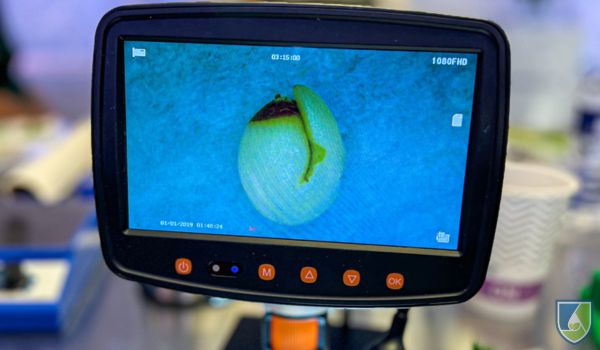
An Overview of Embryo Culture
As a content and community manager, I leverage my expertise in plant biotechnology, passion for tissue culture, and writing skills to create compelling articles, simplify intricate scientific concepts, and address your inquiries. As a dedicated science communicator, I strive to spark curiosity and foster a love for science in my audience.


What Is Embryo Culture?
Crossbreeding different plant varieties, followed by careful selection, has been a cornerstone of crop improvement.
One biotechnological technique is embryo culture. This involves nurturing immature or mature embryos in a controlled environment to produce viable plants.
The embryo is a multicellular structure that has the potential to develop into a whole plant. So, generally when two plants of the same species undergo sexual reproduction, the process forms embryo.
However, this natural process often fails when two different species within the same genus are crossed (known as interspecies crossing). The failure is usually due to obstacles in pollination, the fertilization of pollen and eggs, or embryogenesis.
This is where embryo culture is hugely important.
The concept is that even embryos that would typically fail to develop naturally can be rescued and grown into viable plants if given the appropriate conditions.
Cultivating immature embryos is challenging due to precise dissection and complex nutrient requirements. Success hinges on the embryo's developmental stage when isolated.
In contrast, culturing mature embryos is simpler and requires less specialized conditions. This technique can overcome seed dormancy issues and accelerate breeding cycles.
In this article, we will learn about the brief history of embryo culture, types and steps involved in embryo culture, and the diverse applications of the technique.

A Brief History of Embryo Culture
- 1904: Hannig first successfully cultures mature embryos of crucifers on a mineral salt medium with sugar, marking the beginning of embryo culture.
- 1924: Dietrich demonstrates that both mature and immature embryos can germinate without the usual dormancy period.
- 1925: Laibach introduces zygotic embryo culture for overcoming interspecific hybridization barriers, using Linum species as a model.
- 1941: Van Overbeek et al. discover the importance of coconut milk and reduced nitrogen for embryo growth, leading to significant advancements in culture media development.
- 1959: Reinert and Steward successfully regenerate embryos from plant cell cultures.
- 1964: Guha and Maheshwari produce the first haploid embryos from pollen grains.
- 1966: Embryo culture technique is applied to a wider range of plants, including Datura, Capsella, and Hordeum.
- 1976: Raghavan discovers that embryos from unsuccessful crosses have the potential to develop normally if cultured in the right conditions.
Types of Embryo Culture
There are two types of embryo culture::
-
Mature Embryo Culture
Mature embryo culture involves isolating fully developed embryos from ripe seeds and growing them in a controlled environment. This technique is useful for overcoming various seed-related challenges.
- Overcoming dormancy: Embryos often remain dormant within seeds due to inhibitory substances or physical barriers. Embryo culture bypasses these obstacles, allowing for direct germination.
- Rescuing viable embryos: In some cases, embryos may be viable but unable to develop normally within the seed. Embryo culture provides a suitable environment for their growth and development.
- Simplified process: Unlike immature embryo culture, mature embryo culture is relatively straightforward, requiring a simple nutrient medium with sugars and minerals.
By isolating the embryo from its natural environment, researchers can study its growth requirements and manipulate conditions for optimal development.
Thus, mature embryo culture can be employed in the following scenarios:
- To generate viable seedlings from sterile seeds.
- To bypass germination barriers in hybrid seeds.
- When hybrid embryos exhibit prolonged seed dormancy.
- If the embryos have low survival rates in vivo.

-
Immature Embryo Culture
Immature embryo culture is a specialized technique used to rescue embryos that would normally fail to develop within the seed. This process involves carefully extracting immature embryos from developing seeds and cultivating them under controlled conditions.
The primary reason for employing this method is to overcome genetic incompatibilities that often arise in hybrid crosses.
When plants from different species or even distinct varieties are crossed, the resulting embryos frequently abort due to genetic barriers or endosperm dysfunction. By isolating the embryo and providing a suitable growth environment, scientists can bypass these hurdles and successfully develop new plant varieties.
Embryo rescue intervention can be used in the following situations:
- To address germination problems in F1 due to dormancy or other issues, and to overcome F1 sterility.
- When the hybrid endosperm doesn't develop properly.
- To prevent the production of harmful substances from the hybrid endosperm that inhibit embryo growth.
- To avoid the occurrence of chlorotic mutants in F1.
- When slow development in the hybrid embryo happens due to differences in the parent embryos' growth patterns, leading to flower drop.
Steps of Embryo Culture

- Sterilization:
- While the embryo itself is often sterile, the surrounding ovule or ovary needs to be surface sterilized to prevent contamination.
- Harsh sterilization techniques can be used due to the embryo's protected location within the seed.
NOTE: Direct disinfection of embryos is required if seedcoats are cracked or if endophytic pathogens exist inside the seedcoats. Examples include fescue (Festuca spp. L.), corn (Zea mays L.), and dogwood (Cornus spp. L.) seeds.
- Embryo Extraction:
- Carefully removing the embryo from the surrounding tissues requires precision.
- Large embryos can be extracted with relative ease, but smaller ones necessitate the use of microsurgical tools.
- Gentle handling is crucial to avoid damage to the delicate embryonic tissue.
- Ensure the excised embryo does not become desiccated during culture. Maintain appropriate moisture levels to keep the embryo viable.
- The excision process varies with species. For many species, an incision at the micropylar end of the ovule followed by applying pressure at the opposite end can force the embryo out through the opening. If liquid endosperm surrounds the embryo, apply pressure cautiously to avoid injuring the fragile embryonic tissue.
- Culture Initiation:
- The excised embryo is transferred to a sterile culture medium designed to support its growth and development.
- For early-stage embryos, maintaining the suspensory tissue is often critical for successful culture.
- The specific culture conditions (medium composition, temperature, light, etc.) will vary depending on the plant species.

Applications of Embryo Culture
Embryo culture has been instrumental in overcoming various challenges in plant breeding. Its primary applications include:
- Rescue of Hybrid Embryos: Embryo culture is crucial for overcoming genetic incompatibility barriers in hybrid crosses. By isolating and culturing embryos, researchers can bypass endosperm failures and produce viable hybrid plants.
- Overcoming Seed Dormancy: For seeds with prolonged dormancy, embryo culture offers a solution by bypassing the dormancy period and initiating germination. This technique is particularly useful when the cause of dormancy is unknown.
- Seed Sterility: Embryo culture allows for the production of seedlings from sterile seeds, expanding the possibilities for plant breeding and genetic studies.
- Plant Regeneration: Embryo-derived callus often exhibits higher regeneration potential compared to callus from other plant tissues. This makes it a valuable tool for plant propagation and genetic modification.
- Haploid Production: In certain cases, embryo culture can lead to the development of haploid plants, which are valuable for plant breeding and genetic studies.
- Biotechnological Applications: Embryo culture provides opportunities for gene transfer and genetic modification techniques, as embryos are more receptive to such manipulations.
- Understanding Embryo Development: Studying embryos in controlled culture conditions provides insights into the factors influencing normal and abnormal embryo development.
Plant Cell Technology: Your Partner In Plant Tissue Culture
Are you passionate about plants and inspired by the potential of plant tissue culture? Plant Cell Technology understands your dreams and is here to be your trusted partner in building a booming home lab.
We understand that setting up a home lab and becoming skilled at the plant tissue culture technique can be challenging. However, with the right tools, knowledge, and support, you can cultivate success and unlock a world of possibilities.
How Plant Cell Technology Empowers You:
- Essential Supplies: Access a comprehensive range of high-quality media, agar, gelling agents, culture vessels, and more, ensuring you have the right tools for every step.
- Expert Knowledge: Gain confidence through our informative resources:
- Comprehensive blog articles: Explore topics from basic principles to advanced techniques.
- Master Classes: Immerse yourself in in-depth sessions led by experienced instructors, gaining valuable hands-on experience and mastering advanced techniques.
- Consultation Services: Our experts will provide you with personalized advice and custom solutions, ensuring your home lab journey flourishes.
- Community Connection: Join our vibrant community forum to connect with fellow enthusiasts, share experiences, and stay updated on the latest advancements.
Blog Categories
View by Level
Popular Blogs

How Samantha Bridges the Gap Between the Nursery and the Lab
The Introduction Building a tissue culture program from the ground up requires more than just scientific knowledge—it requires the grit...
Read More
Understanding The Synthetic Seed Technology
Introduction Let’s be honest: traditional plant propagation can be a logistical nightmare. If you’re working with recalcitrant species—those stubborn plants...
Read MoreSubscribe to Our Newsletter
3 comments
well explained
nice content easily understood . nice photo picture









Join the conversation
Your email address will not be published. Required fields are marked